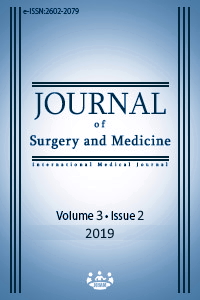Contribution of radiation therapy of head and neck paragangliomas: About 6 cases presentation
Keywords:
Paraganglioma, Radiotherapy, Head and neck, PheochromocytomaAbstract
The neck’s paraganglions are bilateral nodular structures, with the same embryological origin which is the cephalic neural crest. They have a branchiomeric distribution. They have an important secreting function during the embryonic life, and then regress when the adrenal medulla starts functioning. Then only carotid and aortic paraganglions have chemoreceptor, baroreceptor and endocrine proved functions. The paragangliomas are tumors developed at the expense of paraganglions by proliferations of the chief cells (of type I) most of the time. Generally these tumors exhibit a slow growth rate, most often presenting asymptomatically as a space occupying mass lesion witnessed clinically or radiographically. The secreting tumors are very rare (5%). The benignity is the rule but the localization near noble structures makes it a highly risky tumor. This disease is often monofocal but it may also be part of a multifocal disease (6%). Advances in imaging have facilitated the diagnosis and the assessment of this disease. Diagnosis is generally made through a combination of clinical findings and radiographic studies. Surgery is the treatment of choice through total subadventitial resection, and rebuilding of the carotid axis when necessary. Surgery may lead to significant morbidity, resulting from major cranial nerve injury and especially at a late stage in the evolution of the disease. The preoperative embolization can facilitate ablation and reduce morbidity. Precisely, external radiotherapy can de indicated for recurrences, tumoral operating residues, and counter indications.
Downloads
References
Baysal BE. Hereditary paraganglioma targets diverse paraganglia. J Med Genet. 2002;39;617–22.
Van der Mey AG, Maaswinkel-Mooy PD, Cornelisse CJ. Genomic imprinting in hereditary glomus tumors: evidence for new genetic theory. Lancet. 1989;2:1291-4.
Opocher G, Schiavi F. Genetics of pheochromocytomas and paragangliomas. Best Pract Res Clin Endocrinol Metab. 2010;24:943-56.
van der Mey AG, Maaswinkel-Mooy PD, Cornelisse CJ, Schmidt PH, van de Kamp JJ. Genomic imprinting in hereditary glomus tumors: evidence for new genetic theory. Lancet. 1989;ii:1291–4.
Heutink P, van der Mey AG, Sandkuijl LA, et al. A gene subject to genomic imprinting and responsible for hereditary paragangliomas maps to chromosome 11q23-qter. Hum Mol Genet. 1992;1:7–10.
Niemann S, Müller U. Mutations in SDHC cause autosomal dominant paraganglioma, type 3. Nat Genet. 2000;26:268–70.
Astuti D, Latif F, Dallol A, et al. Gene mutations in the succinate dehydrogenase subunit SDHB cause susceptibility to familial pheochromocytoma and to familial paraganglioma. Am J Hum Genet. 2001;69:49–54.
Hao HX, Khalimonchuk O, Schraders M, Dephoure N, Bayley JP, Kunst H, Devilee P, Cremers CW, Schiffman JD, Bentz BG, Gygi SP, Winge DR, Kremer H, Rutter J. SDH5, a gene required for flavination of succinate dehydrogenase, is mutated in paraganglioma. Science. 2009;28:1139–42.
Baysal BE, Ferrell RE, Willett-Brozick JE, et al. Mutations in SDHD, a mitochondrial complex II gene, in hereditary paraganglioma. Science. 2000;287:848–51.
Lips CJM, Lentjes EGWM, Höppener JWM, van der Luijt RB, Moll FL. Familial paragangliomas: Hereditary Cancer in Clinical Practice. 2006;4:169.
Hayes WS, Davidson AJ, Grimley PM, Hartman DS. Extraadrenal retroperitoneal paraganglioma: clinical, pathologic and CT finding AJR Am. J Roentgenol. 1990;155:1247- 50.
Bessell-Browne R, O_Malley ME. CT of pheochromocytoma and paraganglioma; risk of adverse events with i.v. administration of nonionic contrast material. AJR Am J Roentgenol. 2007;188:970-4.
Baeza JC, Jagannathanb JB, Krajewskib K, Kevin O. Pheochromocytoma and paraganglioma: imaging characteristics. Cancer Imaging. 2012;12:153-62.
Miliaras GC, Kyristis AP, Polyzoidis KS. Cauda equina 383 paraganglioma: a review. Journal of Neuro-oncology. 2003;65:177–90.
World Health Organization. Pathology and Genetics: Tumors of Endocrine Organs. Lyon, France: IARC;2004.
Offergeld C, Brase C, Yaremchuk S, Mader I, Rischke HC, Gläsker S, et al. Head and neck paragangliomas: clinical and molecular genetic classification. Clinics (Sao Paulo). 2012;67 Suppl 1:19-28.
Gilbo P, Morris CG, Amdur RJ, Werning JW, Dziegielewski PT, Kirwan J, Mendenhall WM. Radiotherapy for benign head and neck paragangliomas: a 45-year experience.
Cancer. 2014 Dec 1;120(23):3738-43.
Foote RL, Pollock BE, Gorman DA, et al. Glomus jugulare tumor: tumor control and complications after stereotactic radiosurgery. Head Neck. 2002;24:332-8.
Suarez C, Rodrigo JP, Bodeker CC, et al. Jugular and vagal paragangliomas: systematic study of management with surgery and radiotherapy. Head Neck. 2013;35:1195-04.
Jacob JT, Link MJ, Foote RL, Pollock BE. Stereotactic radiosurgery for glomus tumors. New York, NY: Thieme Medical Publishers, Inc; 2009
Downloads
- 1139 1458
Published
Issue
Section
How to Cite
License
Copyright (c) 2019 Sanae Ghammad, Allouche Fadwa, Terrab Fatima Zahra, Chebihi Hassani Ghita, Alami Zenab, Bouhafa Thouria, Hassouni Khalid
This work is licensed under a Creative Commons Attribution-NonCommercial-NoDerivatives 4.0 International License.
















